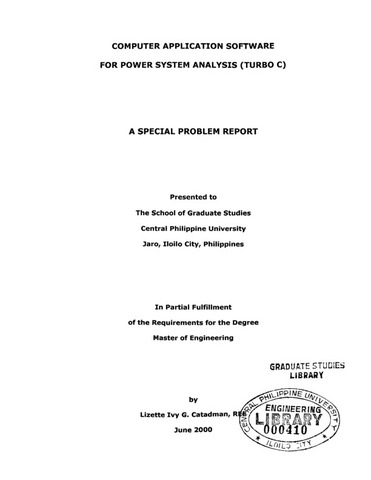Computer application software for power system analysis (Turbo C)
| dc.contributor.adviser | Java, Alberto A. | |
| dc.contributor.author | Catadman, Lizette Ivy G. | |
| dc.date.accessioned | 2021-03-09T07:32:24Z | |
| dc.date.available | 2021-03-09T07:32:24Z | |
| dc.date.issued | 2000 | |
| dc.identifier.citation | Catadman, L. I. G. (2000). Computer application software for power system analysis (Turbo C) (Unpublished Master's special paper). Central Philippine University, Jaro, Iloilo City. | en_US |
| dc.identifier.uri | https://hdl.handle.net/20.500.12852/581 | |
| dc.description | Abstract only | en_US |
| dc.description.abstract | This Special Problem Report presents the process involved in solving Power System Analysis problems with the use of two software programs in Turbo C. Power System Analysis is a course offered on the final year of the Bachelor of Science in Electrical Engineering (BSEE) Curriculum and in the advanced courses of the Master's Degree, which has been known to have the most tedious and time-consuming processes in its calculations. The package is composed of two softwares namely: (Power System Analysis Volume 1) PSAVOL1 and (Power System Analysis Volume 2) PSAVOL2. Two softwares were created so as to separate the calculation processes necessary or intended for those problems that provided for the bus connections, voltage or current sources, and impedance from those in which all electrical bus transmission elements and its corresponding ratings. These softwares will prove to be beneficial to both instructors and students. Even though that these softwares are great tools in absorbing most of the calculations needed, there is still the need for the mastery of some of the methods and techniques involved. The advantage is that it is no longer as "mind-cracking" as it used to be when one does all these calculations manually to be able to reach the end results faster and more accurately. The PSAVOL1 is capable of solving for the Source Currents, Impedance Bus Matrix using Direct Method, Bus Voltages, and simple Bus-Grounded type of fault. The PSAVOL2 is capable of solving for the New Per Unit Impedance values of the Positive, Negative, and Zero Sequences as well as the Positive, Negative, and Zero Sequence Impedance Bus Matrix, and the three types of Symmetrical Shunt Faults namely; Single-Line to Ground, Double-Line to Ground, and Line-Line Fault. | en_US |
| dc.language.iso | en | en_US |
| dc.subject.ddc | GSL Theses 620.0072 C28 | en_US |
| dc.subject.lcsh | Electric power systems | en_US |
| dc.subject.lcsh | Electric power systems--Evaluation | en_US |
| dc.subject.lcsh | Application software | en_US |
| dc.subject.lcsh | Computer software--Development | en_US |
| dc.subject.lcsh | Turbo C++ | en_US |
| dc.subject.lcsh | Computer software | en_US |
| dc.title | Computer application software for power system analysis (Turbo C) | en_US |
| dc.type | Special paper | en_US |
| dc.description.bibliographicalreferences | vii, 109 leaves: illustrations | en_US |
| dc.contributor.chair | David, Fely P. | |
| dc.contributor.committeemember | Rio, Walden S. | |
| dc.contributor.department | School of Graduate Studies | en_US |
| dc.description.degree | Master of Engineering | en_US |


